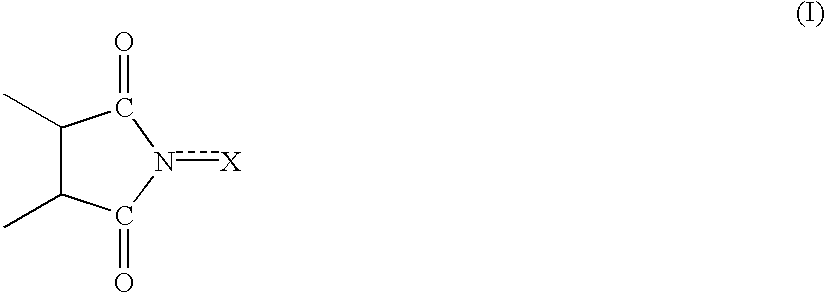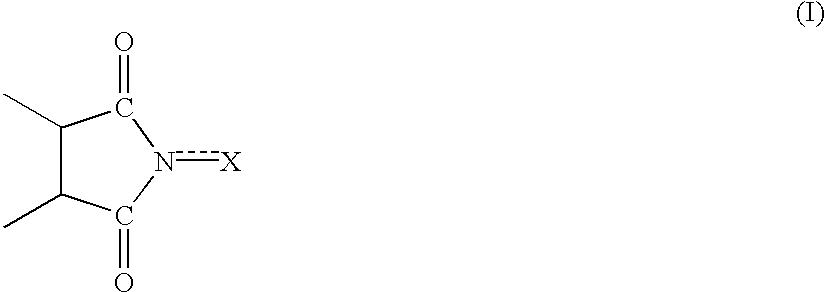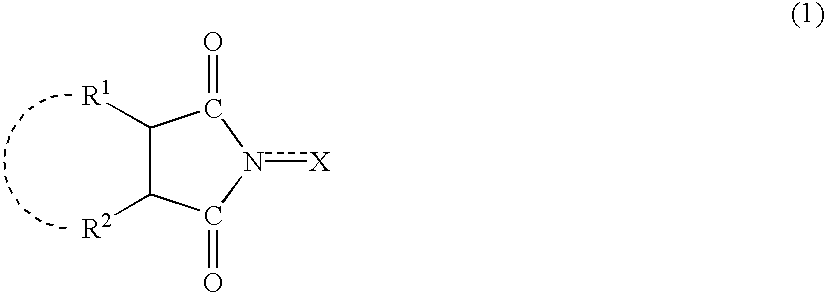Catalyst comprising a cyclic imide compound and process for producing organic compounds using the catalyst
a technology of organic compounds and catalysts, which is applied in the direction of physical/chemical process catalysts, organic compounds/hydrides/coordination complexes catalysts, etc., can solve the problems of substrate decomposition, oxidation process can not easily and efficiently produce alcohols or carboxylic acids under mild conditions, and the catalytic activity of conventional catalytic oxidation processes is maintained over a long time, and the effect of high catalytic activity
- Summary
- Abstract
- Description
- Claims
- Application Information
AI Technical Summary
Benefits of technology
Problems solved by technology
Method used
Image
Examples
preparation example 1
[0354] In a 3-L flask equipped with a stirrer, a thermometer and a dropping funnel, 110 g (522.39 mmol) of anhydrous trimellitic chloride (4-chlorocarbonylphthalic anhydride) and 770 g of 1,4-dioxane were placed and were stirred at room temperature in an atmosphere of a nitrogen gas. To the resulting mixture, a mixture of 92.70 g (497.52 mmol) of 1-dodecanol, 41.32 g (522.39 mmol) of pyridine and 370 g of 1,4-dioxane was added dropwise over 1 hour. The mixture was stirred at room temperature for further 5 hours, followed by dropwise addition of 570 g of pure water over 30 minutes. Pyridine hydrochloride separated in a reaction system was then dissolved, and a crystal of target 4-dodecyloxycarbonylphthalic anhydride separated out. The resulting mixture was stirred for further 1 hour, the precipitate was separated by filtration and was rinsed with pure water, was then dried at 50.degree. C. under reduced pressure and thereby yielded 145.26 g (402.99 mmol) of 4-dodecyloxycarbonylphthal...
example 1
[0360] A mixture of 5 ml (46 mmol) of cyclohexane. 0.75 ml of nitrogen dioxide and 0.25 mmol of 4-dodecyloxycarbonyl-N-hydroxyphthalimide was stirred at 70.degree. C. in an atmosphere of air (1 atm=0.1 MPa) for 15 hours and thereby yielded nitrocyclohexane and cyclohexyl nitrate in yields of 40% and 6%, respectively.
example 2
[0362] A mixture of 4 ml (37 mmol) of cyclohexane, 0.1 mmol of 4-dodecyloxycarbonyl-N-hydroxyphthalimide, 0.01 mmol of cobalt(II) acetate and 0.001 mmol of manganese(II) acetate was stirred at 100.degree. C. in an atmosphere of air (30 atm=3 MPa) for 12 hours and thereby yielded 0.05 mmol of cyclohexyl alcohol, 0.15 mmol of cyclohexanone, 2.88 mmol of adipic acid and 0.39 mmol of glutaric acid. The total amount of the four products was 3.47 mmol, and the amount of K / A oil (a mixture of cyclohexyl alcohol and cyclohexanone) was 0.20 mmol.
PUM
| Property | Measurement | Unit |
|---|---|---|
| temperatures | aaaaa | aaaaa |
| molar volume | aaaaa | aaaaa |
| pKa | aaaaa | aaaaa |
Abstract
Description
Claims
Application Information
 Login to View More
Login to View More - R&D
- Intellectual Property
- Life Sciences
- Materials
- Tech Scout
- Unparalleled Data Quality
- Higher Quality Content
- 60% Fewer Hallucinations
Browse by: Latest US Patents, China's latest patents, Technical Efficacy Thesaurus, Application Domain, Technology Topic, Popular Technical Reports.
© 2025 PatSnap. All rights reserved.Legal|Privacy policy|Modern Slavery Act Transparency Statement|Sitemap|About US| Contact US: help@patsnap.com



